If you found our last blog interesting, well, here is a guide to just but a few of the types of ornamental gardens. They have been there for centuries and well – old is gold!
1. Baroque Gardens.
These mainly apply the use of geometric shapes such as circles, rectangles and triangles. They also apply use of irregular patterns especially the maze. They are very artistic and dramatic landscapes and thus require large areas of land.
The principle of baroque gardens originates from Renee Descartes which supposes that infinite space can be divided by finite objects or designs. Such gardens employ the use of tall hedges or those waist-high with a centre piece in the middle of the garden such as a sculpture. Ornate flowers can be grown around this centre piece or between hedges.
French Formal Garden in Loire Valley
To create a baroque garden, always start from the middle spreading outwards. Divide the area to have the garden using straight lines and design each piece of land individually while maintaining a cohesive whole.
Maintenance of these involves regular pruning and watering, cleaning of the centre piece.
The down side of baroque gardens is that they are expensive to set up especially if centre pieces such as sculptures or fountains are involved.
2. Korean Gardens.
These gardens stick to traditional Korean landscaping principles and are kept as close to natural as possible. They are characterized by evergreen trees, ponds and should there be any decorations, they are formed out of stone. A Korean garden is uniquely designed with regard to its surrounding architecture and particularly its functions.
Water features included in this landscape garden are often not ponds with fish such as koi and plants such as lilies and lotus flowers. If the pond were big, then foot bridges made of timber.
The Korean Garden in Frankfurt, Germany
3. Zen Gardens
Zen gardens originate from the Japanese Muromachi period which coincided with the renaissance in Europe. These gardens were made to imitate nature as is and were an aid to meditation on nature. It is within this era that Zen Buddhism emerged.
Japanese Zen gardens are made out of rock arrangements, sand or gravel, moss, pruned trees and bushes. They are usually surrounded by a stone wall and are not expanse. These are arranged to imitate natural features such as mountains, waterfalls, rivers, islands etcetera. Sand or gravel can be raked into patterns imitating ripples in water.
Daisen-in – Kyoto, Japan
The setting of stones has to follow Zen guidelines. A stone’s best side has to be given prominence in whichever arrangement. They have to be either tall vertical, low vertical, arching, reclining or flat. A “falling” stone must have a supporting one and any that seems to be leading must have followers. Gravel is preferred over sand as it is less disturbed by wind and/or water. Zen Buddhist monks always carefully rake the gravel in the morning.
The beauty of Zen gardens is that they do not take up much space as other types of gardens. More so, they are easy to set up and maintain.
Put forth your best foot (or green thumb) and get yourself a wonderful garden.


